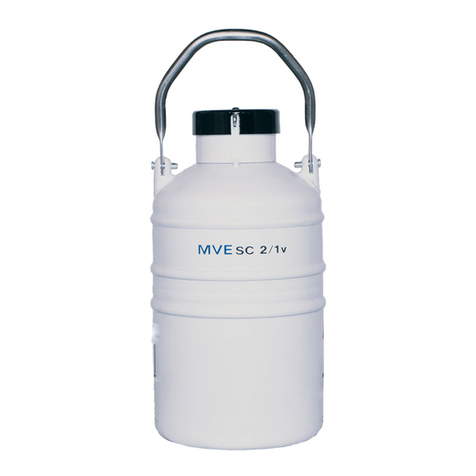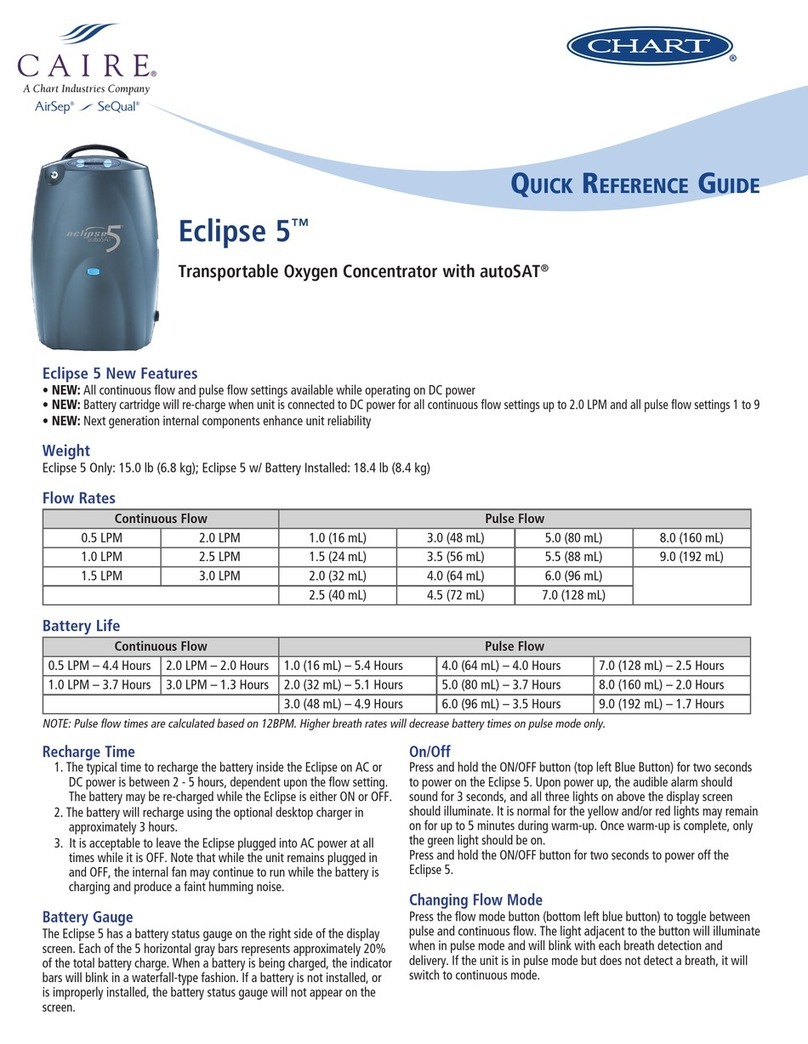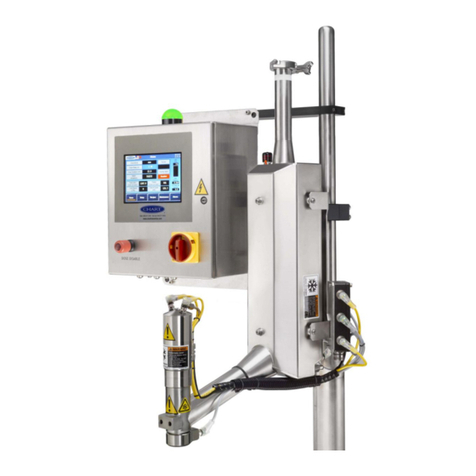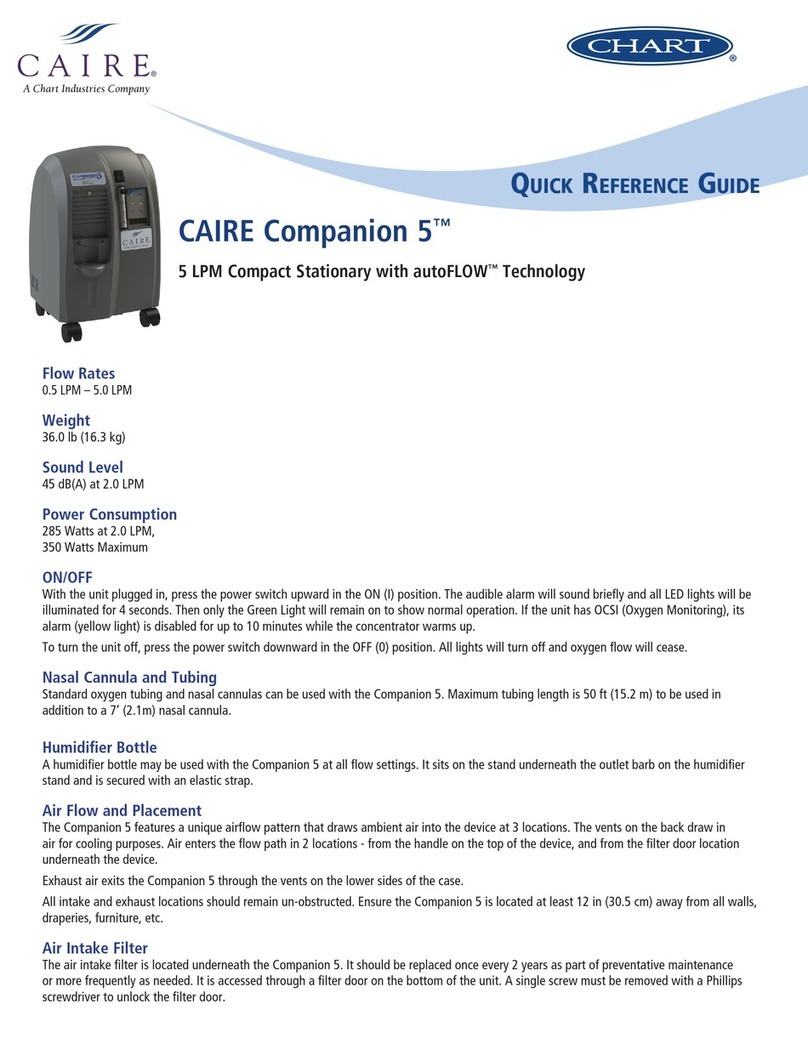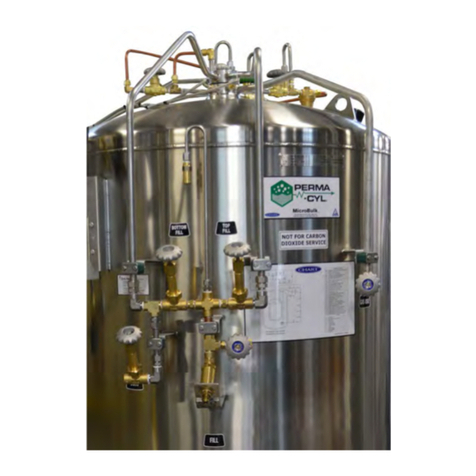CHART VisionAire 2 User manual

VisionAire 2 & 3
User Manual

2 — MN165-1 M
Sym-
bol Denition Symbol Denition
Read user manual before operation.
See user manual for instructions. ON (power switch on)
No Smoking Icon: Do not smoke near
unit. OFF (power switch off)
Warnings and Cautions No serviceable parts inside. Do not open
cover.
Type BF equipment (degree of
protection against electric shock) Class II equipment
Complies with the 93/42/EEC directive
drawn up by the approved organization
No. 0459
Safety agency for CAN/CSA C22.2
No. 601.1 M90 for medical electrical
equipment
Keep unit and accessories dry Use no oil or grease.
Consult the accompanying documents
This symbol is to remind the equipment
owners to return it to a recycling facility
at the end of its life, per Waste Electrical
and Electronic Equipment (WEEE)
Directive. Proper disposal of waste
of electrical and electronic equipment
required.
Oxygen outlet connection to the
cannula Do not expose to open ames
Caution: Federal law (USA) restricts
this for sale or rental by or on the order
of a physician or licensed health care
provider.
Keep in the vertical position
Fragile – handle with care Oxygen concentration warning LED
Date of Manufacture Name and address of manufacturer
Serial number Authorized representative in the
European Community
Catalog number
User Controls & System Status Indicators

VisionAire 2 & 3 User Manual — 3
Contents
User Controls & System Status Indicators................................................................................. 2
Indications for Use ............................................................................................................................ 4
Contraindications for Use............................................................................................................... 4
Safety Guidelines............................................................................................................................... 4
Introduction ........................................................................................................................................ 8
Concentrator Components............................................................................................................ 9
Operating Instructions ..................................................................................................................12
Care and Cleaning...........................................................................................................................13
Troubleshooting ..............................................................................................................................14
Product Specications...................................................................................................................15
Disposal...............................................................................................................................................19
English: A multilingual version of the manual is available through your equipment provider.
Español: Una versión multilingüe del manual está disponible a través de su proveedor de equipo.
Français: Une version multilingue du manuel est disponible par l’intermédiaire de votre fournisseur de
matériel.
Deutsche: Eine mehrsprachige Version des Handbuchs ist in Ihrer Geräte-Anbieter

4 — MN165-1 M
Important!
Safety Instructions are dened as fol-
lows:
Indications for Use
Contraindications for Use
Safety Guidelines
WARNING: IMPORTANT SAFETY INFORMATION
FOR HAZARDS THAT MIGHT CAUSE SERIOUS
INJURY.
CAUTION: Important information for preventing
damage to the VisionAire.
Note: Information needing special attention.
WARNING: IT IS VERY IMPORTANT TO SELECT
ONLY THE PRESCRIBED LEVEL OF OXYGEN. DO
NOT CHANGE THE FLOW SELECTION UNLESS
YOU HAVE BEEN DIRECTED TO DO SO BY A
LICENSEDCLINICIAN.THEPORTABLEOXYGENCONCENTRA
TORMAY BEUSED DURINGSLEEP UNDERTHE RECOMMEN
DATION OF A QUALIFIED CLINICIAN.
WARNING: FEDERAL USA LAW RESTRICTS THIS DEVICE
TO SALE OR RENTAL BY ORDER OF A PHYSICIAN OR OTHER
LICENSED HEALTH CARE PROVIDER.
WARNING:THIS UNIT IS NOT TO BE USED FOR LIFE
SUPPORT. GERIATRIC, PEDIATRIC, OR ANY OTHER PATIENT
UNABLE TO COMMUNICATE DISCOMFORT WHILE USING
THIS DEVICE MAY REQUIRE ADDITIONAL MONITORING.
PATIENTS WITH HEARING AND/OR SIGHT IMPAIRMENTS
MAY NEED ASSISTANCE WITH MONITORING ALARMS.
WARNING: NO MODIFICATION OF THIS EQUIP
MENT IS PERMITTED
WARNING: IN CERTAIN CIRCUMSTANCES, THE
USE OF NONPRESCRIBED OXYGEN CAN BE
HAZARDOUS. THIS DEVICE SHOULD ONLY BE
USED WHEN PRESCRIBED BY A PHYSICIAN.
WARNING:NOT FOR USEINTHE PRESENCE OF FLAMMABLE
ANESTHETICS.
WARNING: ASWITH ANY ELECTRICALLY POWERED DEVICE,
THE USER MAY EXPERIENCE PERIODS OF NONOPERATION
AS A RESULT OF ELECTRICAL POWER INTERRUPTION, OR
THE NEED TO HAVETHE VISIONAIRE SERVICED BY A QUAL
IFIED TECHNICIAN. THE VISIONAIRE IS NOT APPROPRIATE
FOR ANY PATIENT WHO WOULD EXPERIENCE ADVERSE
HEALTH CONSEQUENCES ASTHE RESULT OF SUCHTEMPO
RARY INTERRUPTION.
WARNING: SMOKING WHILE USING OXYGEN IS
THE NUMBER ONE CAUSE OF FIRE, INJURY, AND
DEATH. YOU MUST FOLLOW THESE SAFETY
WARNINGS:
WARNING: DO NOT ALLOW SMOKING, CANDLES, OR OPEN
FLAMES WITHIN THE SAME ROOM OF THE DEVICE OR THE
OXYGENCARRYING ACCESSORIES.
WARNING: SMOKING WHILE WEARING AN OXYGEN CAN
NULA CAN CAUSE FACIAL BURNS AND POSSIBLY RESULT
IN DEATH.
WARNING: REMOVING THE CANNULA AND PLACING IT
ON CLOTHING, BEDDING, SOFAS, OR OTHER CUSHION
MATERIALWILL CAUSE A FLASH FIRE WHEN EXPOSEDTO A
CIGARETTE, HEAT SOURCE, SPARK OR OPEN FLAME.
WARNING: IF YOU SMOKE, YOU MUST ALWAYS FOLLOW
THESE 3 IMPORTANT STEPS FIRST: TURN OFF THE OXYGEN
CONCENTRATOR,TAKEOFFTHE CANNULA,ANDLEAVETHE
ROOM WHERE THIS DEVICE IS LOCATED.
Note:PortableandmobileRFcommunicationsequipmentcan
eect medical electrical equipment.
CAUTION: Federal (USA) law restricts this de-
vice to sale or rental by order of a physician
or other licensed health care provider.
WARNING: THIS DEVICE SUPPLIES HIGHCON
CENTRATION OXYGENTHAT PROMOTESRAPID
BURNING. DO NOT ALLOW SMOKING OR OPEN
FLAMES WITHIN THE SAME ROOM OF 1 THIS
DEVICE, OR 2 ANY OXYGENCARRYING AC
CESSORY.FAILURETOOBSERVETHISWARNINGCANRESULT
IN SEVERE FIRE, PROPERTY DAMAGE AND / OR CAUSE
PHYSICAL INJURY OR DEATH.
WARNING:DO NOT USEYOUR OXYGEN CONCENTRATOR IN
THE PRESENCE OF FLAMMABLE GASES.THIS CAN RESULT
IN RAPID BURNING CAUSING PROPERTY DAMAGE, BODILY
INJURIES OR DEATH.
WARNING: DO NOT LEAVE A NASAL CANNULA ON CLOTH
ING, BED COVERINGS OR CHAIR CUSHIONS. IF THE UNIT IS
TURNED ON BUT NOT IN USE,THE OXYGENWILL MAKETHE
MATERIAL FLAMMABLE. SET THE I/0 POWER SWITCH TO
THE0OFFPOSITIONWHENTHEOXYGENCONCENTRATOR
IS NOT IN USE.
WARNING: USE NO OIL, GREASE, OR PETROLEUMBASED
OR OTHER FLAMMABLE PRODUCTS WITH THE OXY
GENCARRYING ACCESSORIES OR THE OXYGEN CON
CENTRATOR. ONLY WATER BASED, OXYGEN COMPATIBLE
LOTIONS OR SALVES SHOULD BE USED. OXYGEN ACCELER
ATES THE COMBUSTION OF FLAMMABLE SUBSTANCES.
WARNING: CLEAN THE CABINET, CONTROL PANEL, AND
POWER CORD ONLY WITH A MILD HOUSEHOLD CLEANER
APPLIEDWITHADAMPCLOTHNOTWETORSPONGE,AND
THENWIPEALLSURFACESDRY.DONOTALLOWANYLIQUID
TO GET INSIDE THE DEVICE.

VisionAire 2 & 3 User Manual — 5
CAUTION: In the event of an alarm or you
observe the Oxygen Concentrator is not
working properly; consult the Troubleshoot-
ing section in this manual. If you cannot
resolve the problem, consult your Equipment Provider.
CAUTION: To prevent a void warranty, follow all manufac-
turers’instructions.
WARNING: SMOKING WHILE USING OXYGEN
IS THE NUMBER ONE CAUSE OF FIRE INJURIES
AND RELATED DEATHS. YOU MUST FOLLOW
THESE SAFETY WARNINGS:
WARNING: DO NOT ALLOW SMOKING, CANDLES, OR OPEN
FLAMES IN THE SAME ROOM WITH THE DEVICE OR THE
OXYGENCARRYING ACCESSORIES.
WARNING: SMOKING WHILE WEARING AN OXYGEN CAN
NULA MAY CAUSE FACIAL BURNS AND POSSIBLY DEATH.
WARNING: IF YOU SMOKE, THESE 3 STEPS MAY SAVE YOUR
LIFE: TURN OFF THE OXYGEN CONCENTRATOR, TAKE OFF
THE CANNULA,AND LEAVETHE ROOMWHERE THISDEVICE
IS LOCATED.
WARNING:“NO SMOKING OXYGEN IN USE”SIGNS MUST
BEPROMINENTLYDISPLAYED INTHEHOME,ORWHERE OX
YGEN IS IN USE. PATIENTS AND THEIR CAREGIVERS MUST
BE INFORMED ABOUT THE DANGERS OF SMOKING IN THE
PRESENCE OF, OR WHILE USING, MEDICAL OXYGEN.
WARNING:DO NOT USEYOUR OXYGEN CONCENTRATOR IN
THE PRESENCE OF FLAMMABLE GASES.THIS CAN RESULT
IN RAPID BURNING CAUSING PROPERTY DAMAGE, BODILY
INJURIES OR DEATH.
WARNING: REMOVING THE CANNULA AND PUTTING IT
ON CLOTHING, BEDDING, SOFAS, OR OTHER CUSHION
MATERIALWILL CAUSE A FLASH FIRE WHEN EXPOSEDTO A
CIGARETTE, HEAT SOURCE, OR FLAME.
WARNING: DO NOT LEAVE A NASAL CANNULA ON OR
UNDER CLOTHING, BED COVERINGS OR CHAIR CUSHIONS.
IF THE UNIT IS TURNED ON BUT NOT IN USE, THE OXYGEN
WILL MAKE THE MATERIAL FLAMMABLE. SET THE OXYGEN
CONCENTRATOR TO THE 0 OFF POSITION WHEN THE
OXYGEN CONCENTRATOR IS NOT IN USE.
WARNING: DO NOT ATTEMPT ANY MAINTE
NANCE OTHER THAN THE POSSIBLE SOLU
TIONS LISTED WITHINTHIS MANUAL. DO NOT
REMOVE COVERS, ONLY YOUR EQUIPMENT
PROVIDERORAQUALIFIEDSERVICETECHNICIANSHOULD
REMOVE THE COVERS OR SERVICE THIS DEVICE.
WARNING: ONLY ACCESSORIES RECOMMENDED BY
THE MANUFACTURER. USE OF ANY OTHER MAY BE
HAZARDOUS,CAUSESERIOUSDAMAGETOYOUROXYGEN
CONCENTRATOR AND WILL VOID THE WARRANTY .
CAUTION: Always place oxygen supply tubing
and power cords in a manner that prevents a
trip hazard.
WARNING: THE MANUFACTURER RECOM
MENDS AN ALTERNATE SOURCE OF SUPPLE
MENTAL OXYGEN IN THE EVENT OF A POWER
OUTAGE, ALARM CONDITION, OR MECHANI
CAL FAILURE. CONSULTYOUR PHYSICIAN OR EQUIPMENT
PROVIDER FORTHETYPEOF RESERVESYSTEM REQUIRED.
WARNING: DO NOT ALLOW EITHER THE AIR INTAKE OR
THE AIR OUTLET VENTS TO BECOME BLOCKED. DO NOT
DROP OR INSERT ANY OBJECTS INTO ANY OPENINGS ON
THE DEVICE.THIS CAN CAUSETHE OXYGEN CONCENTRA
TOR TO OVERHEAT AND IMPAIR PERFORMANCE.
WARNING: ELECTRICAL SHOCK HAZARD.
TURN OFF THE UNIT AND DISCONNECT THE
POWER CORD FROM THE ELECTRIC OUTLET
BEFORE YOU CLEAN THE UNIT TO PREVENT
ACCIDENTAL ELECTRICAL SHOCK AND BURN HAZARD.
ONLY YOUR EQUIPMENT PROVIDER OR A QUALIFIED
SERVICE TECHNICIAN SHOULD REMOVE THE COVERS OR
SERVICE THE UNIT.
WARNING: CARE SHOULD BE TAKEN TO PREVENT THE
OXYGEN CONCENTRATOR FROM GETTING WET OR
ALLOWING FLUIDS TO ENTER THE UNIT. THIS CAN CAUSE
THEUNITTOMALFUNCTIONORSHUTDOWN,ANDCAUSE
AN INCREASED RISK FOR ELECTRICAL SHOCK OR BURNS.
WARNING: DO NOT USE LIQUID DIRECTLY ON THE UNIT.
A LIST OF UNDESIRABLE CHEMICAL AGENTS INCLUDES
BUT IS NOT LIMITED TO THE FOLLOWING: ALCOHOL
AND ALCOHOLBASED PRODUCTS, CONCENTRATED
CHLORINEBASEDPRODUCTSETHYLENECHLORIDE,AND
OILBASED PRODUCTS PINESOL®, LESTOIL®. THESE
ARE NOT TO BE USED TO CLEAN THE PLASTIC HOUSING
ONTHEOXYGENCONCENTRATOR,ASTHEYCANDAMAGE
THE UNIT’S PLASTIC.
WARNING: THE OXYGEN CONCENTRATOR
SHOULD NOT BE USED ADJACENT TO OR
STACKED WITH OTHER EQUIPMENT. IF AD
JACENT OR STACKED USE IS UNAVOIDABLE,
THE DEVICE SHOULD BE OBSERVED TO VERIFY NORMAL
OPERATION.
WARNING: NO MODIFICATION OF THIS EQUIPMENT IS
PERMITTED.
WARNING: USE OF CABLES AND ADAPTERS OTHER THAN
THOSE SPECIFIED, WITH THE EXCEPTION OF CABLES AND
ADAPTERSSOLDBYTHEMANUFACTUREROFTHEMEDICAL
ELECTRICAL EQUIPMENT AS REPLACEMENT PARTS FOR
INTERNAL COMPONENTS, MAY RESULT IN INCREASED
EMISSIONS OF DECREASED IMMUNITY OF THE OXYGEN
CONCENTRATOR.
WARNING: USE ONLY ELECTRICAL VOLTAGE AS SPECIFIED
ON THE SPECIFICATION LABEL AFFIXED TO THE DEVICE.
WARNING: DO NOT USE EXTENSION CORDS WITH THIS
UNIT OR CONNECT TOO MANY PLUGS INTO THE SAME
ELECTRICAL OUTLET. THE USE OF EXTENSION CORDS
COULD ADVERSELY AFFECT THE PERFORMANCE OF THE
DEVICE.TOO MANY PLUGS INTO ONE OUTLET CAN RESULT
IN AN OVERLOADTOTHE ELECTRICAL PANEL CAUSINGTHE
BREAKER/FUSE TO ACTIVATE OR FIRE IF THE BREAKER OR
FUSE FAILS TO OPERATE.
This manual suits for next models
1
Table of contents
Other CHART Medical Equipment manuals
Popular Medical Equipment manuals by other brands

Getinge
Getinge Arjohuntleigh Nimbus 3 Professional Instructions for use

Mettler Electronics
Mettler Electronics Sonicator 730 Maintenance manual

Pressalit Care
Pressalit Care R1100 Mounting instruction

Denas MS
Denas MS DENAS-T operating manual

bort medical
bort medical ActiveColor quick guide

AccuVein
AccuVein AV400 user manual
